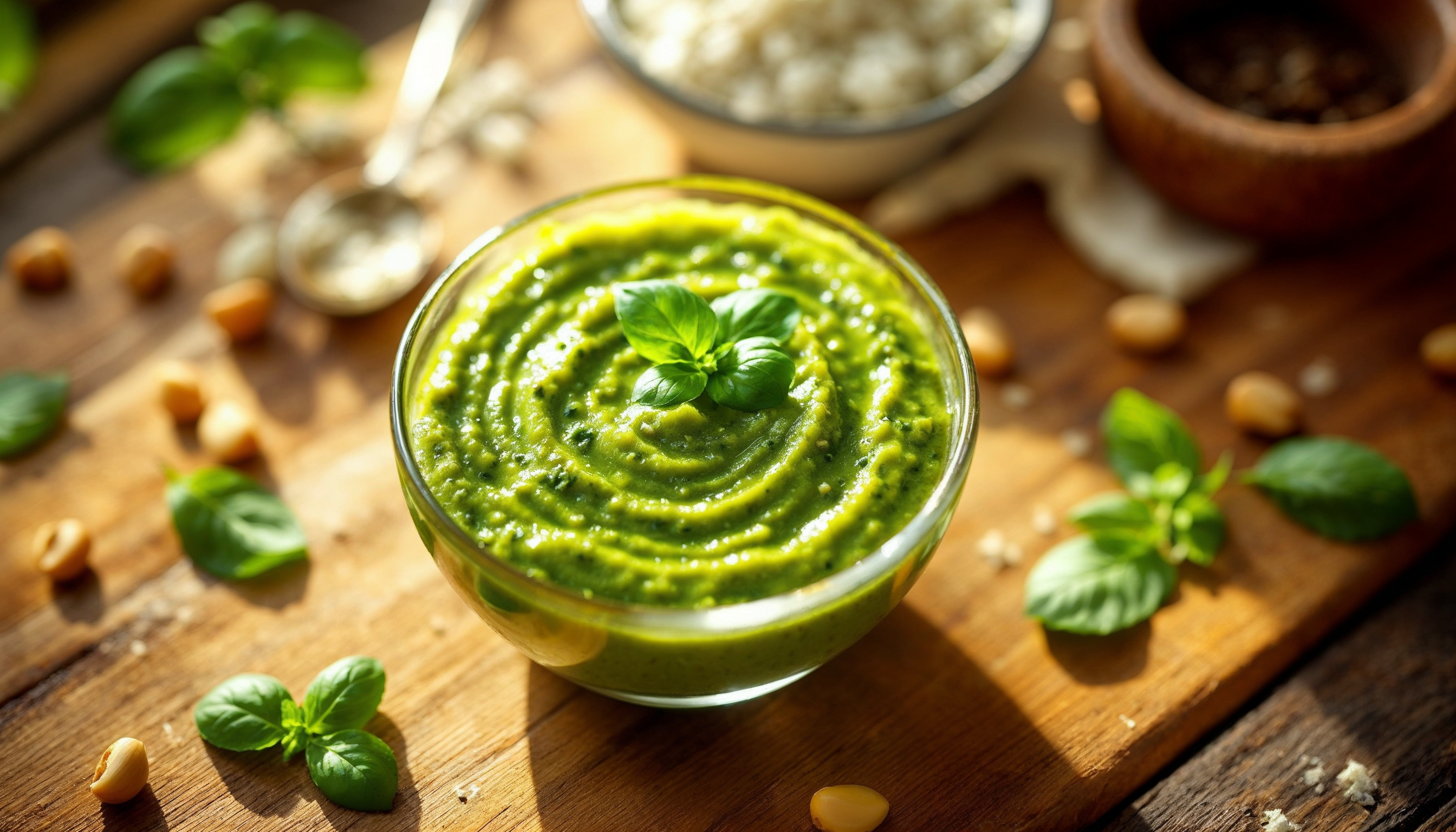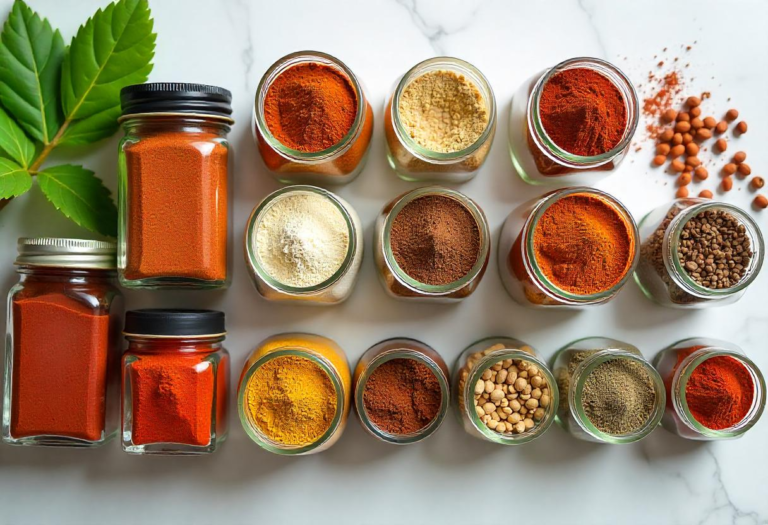The UltimateF Recipe: A Fresh and Flavorful Classic
Table of Contents
Have you ever taken a bite of pasta with fresh, vibrant pesto and felt instantly transported to the Italian countryside? That brilliant green sauce with its aromatic basil, rich olive oil, and nutty undertones is nothing short of culinary magic. This is your ultimate guide to making perfect pesto sauce from scratch. Whether you’re a kitchen novice or a seasoned home chef, this pesto sauce recipe will elevate your meals to restaurant quality with minimal effort.
Have you ever struggled to get the right consistency? Wondering if you can use walnuts instead of pine nuts? This recipe covers it all! I’ll walk you through every step of creating this versatile Italian classic that can transform ordinary dishes into extraordinary meals.
What is Pesto? A Journey Through Italian Tradition
Pesto originates from Genoa in the Liguria region of northern Italy, where it has been a culinary staple for centuries. The word “pesto” comes from the Italian verb “pestare,” meaning “to pound” or “to crush,” referring to the traditional method of grinding the ingredients with a mortar and pestle.
Traditional Genoese pesto, known as Pesto alla Genovese, has been made the same way for generations, with locals insisting on using only the freshest, highest-quality ingredients. This respect for tradition and quality is what gives authentic pesto its unmistakable flavor and character.
Essential Ingredients: The Building Blocks of Perfect Pesto
Basil
The star of any homemade pesto recipe is fresh basil. Genovese basil, with its sweet, aromatic qualities, is the traditional choice. When selecting basil, look for vibrant green leaves without any dark spots or wilting. The leaves should be fragrant and tender. For the most authentic flavor, avoid substituting other herbs, though in a pinch, a combination of basil and parsley can work.
Pine Nuts
These small, buttery nuts add a distinctive richness to pesto sauce. Traditional recipes call for raw pine nuts, but lightly toasting them can enhance their flavor. Pine nuts can be expensive and some people experience “pine mouth syndrome” (a temporary bitter taste that develops after consuming them). If needed, walnuts, almonds, or even sunflower seeds make excellent alternatives while maintaining that essential nutty character.
Garlic
Fresh garlic provides the pungent kick that balances the sweetness of basil. Use fresh cloves rather than pre-minced garlic for the brightest flavor. One to three cloves is standard, depending on your preference and the size of the cloves. To minimize garlic’s sharpness, remove the green sprout in the center of the clove if present.
Parmesan Cheese
Authentic pesto uses Parmigiano-Reggiano, aged for at least 24 months for optimal flavor. Always buy a block and grate it yourself – pre-grated cheese contains anti-caking agents and loses flavor quickly. For a slightly sharper taste, Pecorino Romano (sheep’s milk cheese) can be used either alone or in combination with Parmesan.
Olive Oil
Use only high-quality extra virgin olive oil with a mild, fruity flavor profile. The oil binds the ingredients together and creates the sauce’s smooth texture. A robust or peppery oil can overpower the delicate basil flavor, so choose wisely. This is one ingredient where quality truly matters.
Salt
A pinch of sea salt or kosher salt enhances all the other flavors while helping to preserve the pesto. Add salt gradually and taste as you go to avoid over-salting.
Equipment: Traditional vs. Modern Methods
Mortar and Pestle
The traditional method involves using a marble mortar and wooden pestle to crush the ingredients by hand. This process releases the oils in the basil without heating them, which preserves both color and flavor. The resulting texture has small, identifiable bits of each ingredient, creating a more rustic and authentic pesto with less bitterness.
Food Processor
For convenience, a food processor produces excellent results in a fraction of the time. The key is using the pulse function rather than continuous processing, which can heat the ingredients and lead to bitterness. Process the basil in short bursts, scraping down the sides frequently to ensure even texture.
The Pesto Sauce Recipe: Step-by-Step Instructions
Ingredients:
- 2 cups fresh basil leaves, packed (about 2 large bunches)
- 3 tablespoons pine nuts (toasted or raw)
- 2 cloves garlic, peeled
- 1/2 cup freshly grated Parmigiano-Reggiano
- 1/2 cup extra virgin olive oil
- 1/4 teaspoon salt (adjust to taste)
- 1-2 tablespoons fresh lemon juice (optional)
Instructions for Food Processor Method:
- Prepare the basil: Gently wash basil leaves and pat completely dry with paper towels. Wet basil will make watery pesto.
- Toast the pine nuts (optional): In a dry skillet over medium heat, toast pine nuts until lightly golden, about 2-3 minutes, stirring constantly to prevent burning. Let cool completely.
- Process the dry ingredients: Add garlic to the food processor and pulse a few times until chopped. Add pine nuts and pulse until coarsely ground. Add the basil leaves and salt.
- Add the oil: With the processor running, slowly drizzle in the olive oil through the feed tube until the mixture is smooth but still has some texture.
- Finish with cheese: Transfer the mixture to a bowl and fold in the grated Parmesan by hand. This prevents the cheese from becoming gummy in the processor.
- Adjust seasoning: Taste and add more salt if needed. For brightness, you can add a squeeze of lemon juice.
Instructions for Mortar and Pestle Method:
- Crush the garlic: Place garlic and salt in the mortar and crush until it forms a smooth paste.
- Add the pine nuts: Add the pine nuts and continue crushing until they’re incorporated into the paste.
- Work in the basil: Add a handful of basil leaves at a time, crushing with a circular motion until each batch is broken down before adding more.
- Add the cheese: Mix in the grated Parmesan, continuing to work with the pestle until well combined.
- Incorporate the oil: Slowly drizzle in the olive oil while mixing with the pestle until you achieve the desired consistency.
Pesto Variations: Creative Twists on the Classic
Sun-Dried Tomato Pesto
Replace half the basil with 1/2 cup drained oil-packed sun-dried tomatoes for a sweet, tangy variation.
Vegan Pesto
Substitute 3 tablespoons nutritional yeast for the Parmesan and add an extra tablespoon of pine nuts for richness.
Arugula Pesto
Replace half the basil with arugula for a peppery, slightly bitter profile that pairs beautifully with steak or roasted vegetables.
Walnut Pesto
Substitute walnuts for pine nuts for a deeper, more robust flavor that stands up well to heartier dishes like whole grain pasta or roasted meats.
Lemon Pesto
Add the zest of one lemon along with the juice for a bright, citrusy version perfect for seafood dishes.
Tips for Perfect Pesto: Troubleshooting & Best Practices
Preventing Bitterness
- Don’t over-process the basil – the heat generated can cause bitterness
- Remove any thick stems from basil leaves
- Use young, fresh basil leaves harvested before the plant flowers
- Add a small amount of lemon juice to brighten the flavor
Achieving the Right Consistency
- For thinner pesto, add more olive oil gradually
- For thicker pesto, add more cheese or nuts
- The consistency should be similar to soft butter when using as a spread, or slightly looser when tossing with pasta
Adjusting the Flavor
- For more garlic intensity, add an extra clove
- For milder garlic flavor, blanch the cloves briefly before using
- Enhance nuttiness by thoroughly toasting the pine nuts
- Balance acidity with a pinch of sugar if needed
How to Store Pesto: Preservation & Shelf Life
Refrigerator Storage
Transfer pesto to an airtight container and pour a thin layer of olive oil on top to prevent oxidation (which causes browning). This will keep in the refrigerator for up to 1 week.
Freezer Storage
For longer preservation, freeze pesto in ice cube trays. Once frozen, transfer the cubes to a freezer bag. This method allows you to use small amounts as needed without thawing the entire batch. Frozen pesto maintains quality for up to 6 months.
Preserving Vibrant Color
Add a small amount of blanched spinach or parsley to help maintain the bright green color during storage. A squeeze of lemon juice also helps prevent browning.
How to Use Pesto: Serving Suggestions & Recipes
Pesto Pasta
Toss 1/4 cup pesto with 8 ounces of freshly cooked and drained pasta. Add a splash of pasta cooking water to help the sauce cling to the noodles. Finish with extra grated cheese and a drizzle of olive oil.
Pesto Pizza
Spread pesto as the base sauce on pizza dough, then top with mozzarella, cherry tomatoes, and prosciutto for a delicious alternative to traditional tomato sauce.
Pesto Sandwiches
Use as a spread on sandwiches and paninis instead of mayonnaise. Particularly delicious with turkey, mozzarella, and roasted red peppers.
Pesto on Grilled Chicken or Fish
Dollop pesto onto grilled chicken breasts or fish fillets during the last minute of cooking, or serve a spoonful on top of the finished dish.
Pesto in Soups
Stir a spoonful into vegetable soups like minestrone just before serving for an instant flavor boost.
Frequently Asked Questions (FAQ)
Can I use frozen basil to make pesto?
Yes, though the texture may be slightly different. Thaw completely and squeeze out excess moisture before using.
Can I make pesto without pine nuts?
Absolutely! Walnuts, almonds, pistachios, or even sunflower seeds make excellent substitutes.
How long does pesto last in the fridge?
With a thin layer of olive oil on top, homemade pesto will last about 5-7 days in the refrigerator.
Can I freeze pesto?
Yes, pesto freezes beautifully. Freeze in ice cube trays, then transfer to freezer bags for up to 6 months.
Is pesto gluten-free?
Traditional pesto is naturally gluten-free, but always check store-bought versions for additives.
Why is my pesto bitter?
Bitterness usually comes from over-processing basil or using older leaves. Try processing in short pulses and using younger, fresher basil.
Conclusion
Making homemade pesto sauce is one of the most rewarding kitchen skills you can master. With just a handful of high-quality ingredients and a few minutes of your time, you can create a versatile sauce that transforms ordinary meals into extraordinary culinary experiences.
This classic pesto sauce recipe can be adapted countless ways to suit your taste preferences and the ingredients you have on hand. Whether you stick to the traditional Genovese method or experiment with creative variations, the vibrant flavors of fresh pesto will brighten your meals and impress your dinner guests.
Leave a comment below and let us know what you think! What’s your favorite way to use pesto in your cooking?


